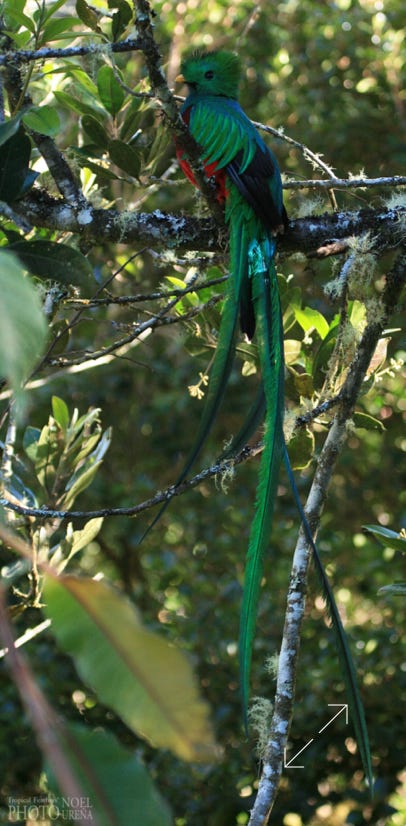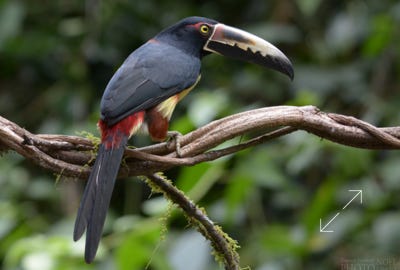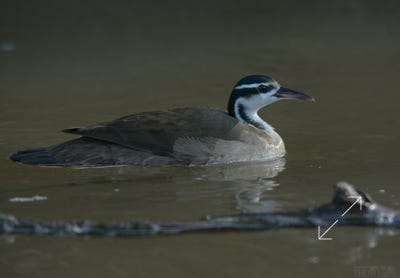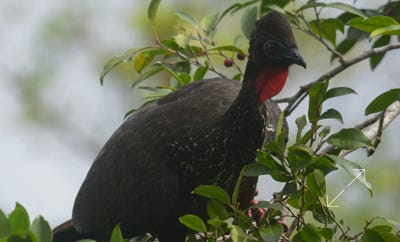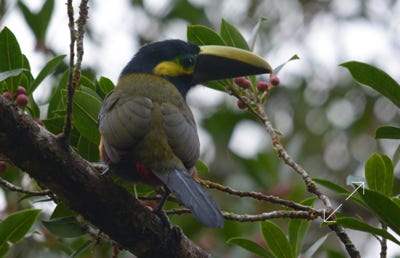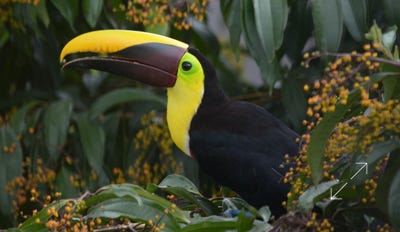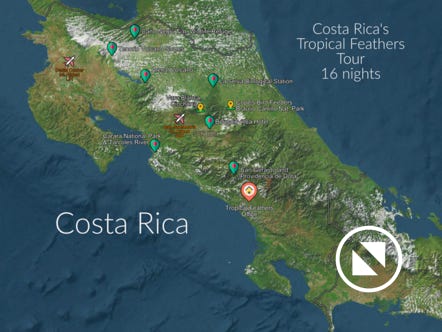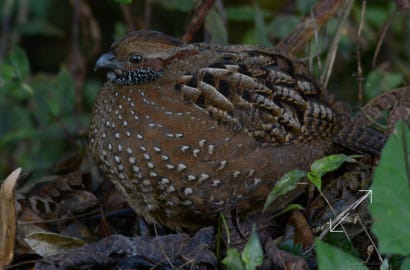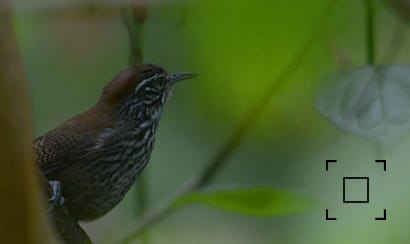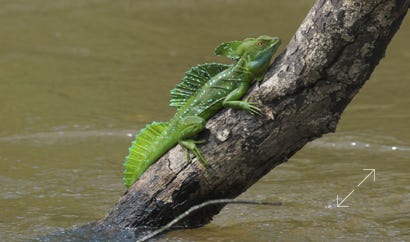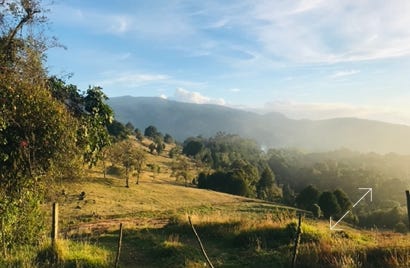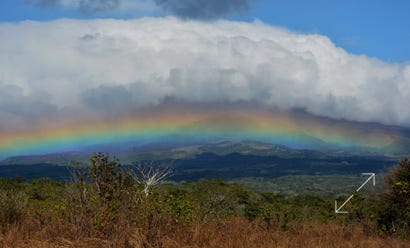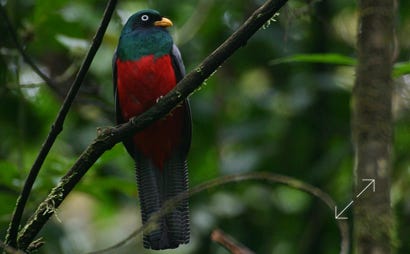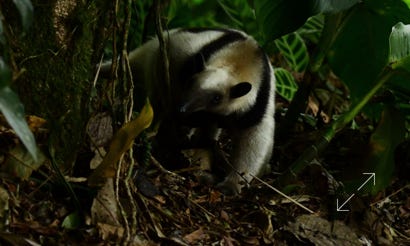
Costa Rica’s Tropical Feathers - 16 Nights
6 different natural areas
Locations to be visited:
1 night - Hotel Bougainvillea or Hotel Buena Vista
3 nights - Celeste Mountain Lodge (Tenorio Volcano slopes)
1 night - Natural Lodge Caño Negro (Caño Negro National Wildlife Refuge wetlands)
2 nights - Arenal Observatory Lodge (northern region’s lowland rainforest, Arenal Volcano environs)
3 nights - La Selva Biological Station (Caribbean lowland rainforest)
3 nights - Savegre Lodge or Sueños del Bosque (highland cloud forest of Talamanca)
2 nights - Cerro Lodge or Villa Lapas (lowland Pacific rainforest)
1 night - Bougainvillea or Hotel Buena Vista
Day 1
Arrive in Costa Rica at SJO. Airport pick up and transport to Hotel Bougainvillea or Hotel Buena Vista. If you land in Liberia’s airport we will be much closer to Celeste Mountain Lodge in which case you can spend the night in the first birding location and depending on the time of the day there might be chance for some birding en route.
Day 2
Begin the day with some early birding on the grounds of Bougainvillea Hotel or Hotel Buena Vista and vicinities. Typical resident bird species include for White-eared Ground-Sparrow, the endemic Cabanis’s Ground-Sparrow, Lesson’s Motmot and Ferruginous Pygmy-Owl. Breakfast then depart for Celeste Mountain Lodge. Birding en route offers chances for dry habitats inhabited by Striped-headed Sparrow, Grasshopper Sparrow, Crested Bobwhite, Elegant Trogon, Thicket Tinamou, Long-tailed Manakin, Double-striped Thick-Knee and White-throated Magpie-Jay. Also birdwatch the the road into Celeste Mountain Lodge where Laughing Falcon and White Hawk are often seen. Ornate Hawk-Eagle, Chestnut-headed Oropendola and Montezuma Oropendola overhead also Brown-hooded Parrot and Rufous-winged Tanager. Lunch on route. Dinner at Celeste Mountain Lodge.
Day 3 and 4
Two full days exploring the slopes of Tenorio Volcano, traverse forests on fairly groomed trails with excellent birding, productive roadsides and open areas near Celeste Lodge and Heliconias Lodge. An amazing collection of bird species awaits in this area’s environs, the elusive Tody Motmot as well as Keel-billed Motmot, Rufous Motmot and Broad-billed Motmot, the secretive Ocellated Antbird, Dull-mantled Antbird, Zeledon’s Antbird and Spotted Antbird, Northern Schiffornis, White-crowned Manakin, Rufous-vented Ground-Cuckoo, the diurnal Central American Pygmy-Owl, Lovely Cotinga, Yellow-eared Toucanet, Lattice-tailed Trogon, Purplish-backed Quail-Dove and Violaceous Quail-Dove, Bare-necked Umbrellabird, White-tipped Sicklebill, Snowcap, Carmiol’s Tanager and Spotted Woodcreeper. This area often produces sightings of Baird’s Tapir. Night birding can regularly produce Crested Owl, Mottled Owl and Spectacled Owl. Meals at the lodge.
Day 5
Depart for Caño Negro National Wildlife Refuge, birding en route may produce Nicaraguan Seed-Finch, Olive-throated Parakeet, Striped Cuckoo, Snowy Cotinga and Painted Bunting. Once in Caño Negro and having checked in into Natural Lodge, prepare for a great afternoon boat tour into this vast wetland area. Part of the spectacular bird life includes Yellow-breasted Crake, Green-and-rufous Kingfisher, American Pygmy Kingfisher, Ringed Kingfisher, Amazon Kingfisher, Green Kingfisher, Belted Kingfisher, Boat-billed Heron, Agami Heron, Jabiru, Roseate Spoonbill, Black-collared Hawk, Snail Kite, Purple Gallinule, Black-bellied Whistling-Duck, Bat Falcon, Pied Puffbird, Bare-crowned Antbird, Green Ibis, Glossy Ibis and Sungrebe. On our return to the lodge and hopefully after having enjoyed a spectacular sunset over the wetlands, we will look for Fishing Bats that readily appear at dusk and skim the water surface for small fish. Going out after dinner for a couple of hours might be an extraordinary choice, bird sightings can include Great Potoo, Common Potoo, Black-and-white Owl and Striped Owl, Pacific Screech-Owl and Common Pauraque.
Day 6
Today, after a cup of coffee, we will take another early boat ride to continue exploring Caño Negro, the soft morning light and enchanting early fog produce an amazing atmosphere for the beginning of our outing. Russet-naped Wood-Rails will probably be foraging along the river banks. Tricolored Heron, Little Blue Heron and Great Blue Heron are normally found in great numbers. Kingfishers should be quite active, and White Ibises, Neotropic Cormorants and Nicaraguan Grackles should be encountered flying to feeding areas. Anhingas will leisurely watch us traverse the waters of the Rio Frio as they perch on emerging fallen tree branches. Spectacled Caimans are very abundant and easily seen along the river banks.
Lunch back at the lodge then depart for the Arenal Volcano area. The road out of Caño Negro is very productive; Pinnated Bittern, Lesser Yellow-headed Vulture, White-throated Crake, Harris’s Hawk, Ruddy-breasted Seedeater are all possible depending on the dynamically fluctuating water levels. Arrive at Arenal Observatory Lodge in the late afternoon.
Day 7
A full day exploring the extensive grounds and trails of Arenal Observatory Lodge and adjacent areas. An early morning visit to the fruit feeders and areas surrounding the main deck can produce excellent views of Montezuma Oropendola, Chestnut-headed Oropendola, Hepatic Tanager, Yellow-throated Euphonia, Red-legged Honeycreeper, Collared Aracari, Great Curassow and Golden-olive Woodpecker. The gardens, trails and fruiting ficus trees can yield good viewings of Rufous-winged Tanager, Crimson-collared Tanager, Emerald Tanager, Olive-backed Euphonia, Smoky-brown Woodpecker, Orange-bellied Trogon, Bare-necked Umbrellabird, Crested Guan, Yellow-eared Toucanet, Ocellated Antbird, Dull-mantled Antbird, Lovely Cotinga, Black-crested Coquette, Violet-headed Hummingbird, Band-backed Wren and Long-tailed Tyrant. Raptors include Ornate Hawk-Eagle, Black Hawk-Eagle, Great Black Hawk, White Hawk, Gray-headed Kite, Hook-billed Kite and King Vulture. The road to and along the lake side is great for Keel-billed Motmot, Bare-crowned Antbird, Thicket Antpitta, White-fronted Nunbird, Three-Wattled Bellbird, Keel-billed Toucan and Yellow-throated Toucan.
Day 8
Depart from Arenal Observatory Lodge. On the way out, briefly explore the habitats bordering the Arenal Lake. Continue the drive towards La Selva Biological Station in the Caribbean lowlands of Puerto Viejo de Sarapiqui. Accessing the foothills of the Central Volcanic Range provides a good chance of finding endemics; Coppery-headed Emerald, Black-bellied Hummingbird, Prong-billed Barbet, Costa Rican Warbler, Sooty-faced Finch as well as resident Green Thorntail, Green Hermit, Purple-throated Mountain-gem, White-bellied Mountain-gem, Violet Sabrewing and Red-headed Barbet. Arrive at La Selva in the late afternoon.
Day 9
Early in the morning you will wake up to the song of birds and powerful far carrying sounds of the Howler Monkeys. Get ready for a full day of great birding in La Selva Biological Station, home of the most studied rainforest in the world. Explore the access road and the grounds around the cafeteria. After breakfast, birdwatch the trails and open areas of the reserve. Some of the numerous bird species at La Selva are Snowy Cotinga, White-collared Manakin, Dusky-faced Tanager, Red-throated Ant-Tanager, Rufous Motmot, Great Tinamou, Little Tinamou, Slaty-breasted Tinamou, Black-headed Tody-Flycatcher, Black-capped Pygmy-Tyrant, Plain-colored Tanager, Black-throated Wren, Blue-chested Hummingbird, White-whiskered Puffbird, Pied Puffbird, Tiny Hawk, Semiplumbeous Hawk, Purple-throated Fruitcrow, Great Curassow, Cinnamon Woodpecker, Mealy Parrot and Red-lored Parrot. Great Green Macaws regularly fly over the station. At night, the station offers great access to look for owls and other wildlife, night birds include Spectacled Owl, Crested Owl and Black-and-white Owl, Middle American Screech-Owl and Great Potoo.
Day 10
Early departure for a day trip to Braulio Carrillo National Park and Cope’s Feeders. An early walk in the wet foothill forest of Braulio Carrillo can produce excellent birds like Black-and-yellow Tanager, Tawny-crested Tanager, Blue-and-gold Tanager, Tawny-capped Euphonia, Lattice-tailed Trogon, Black-eared Wood-Quail, Black-crowned Antpitta, Pale-vented Thrush, Lanceolated Monklet, Ochre-breasted Antpitta, White-crowned Manakin, Sharpbill and Emerald Tanager. In the afternoon we will visit Cope’s Feeders, this is a wonderful site for photography and ideal to observe quite a few species in detail. Cope always walks us around in the woods nearby looking for owl roosts and other interesting wildlife, possible birds include Spectacled Owl, Crested Owl, Bronzed-tailed Plumeleteer, Crimson-collared Tanager, Russet-naped Wood-Rail, White-necked Jacobin and Blue-chested Hummingbird. Cope also offers interesting wildlife sightings. He typically stakes out the nice looking Honduran White Bats, Helmeted Basilisks, vine snakes and sloths. Return to La Selva at the end of the day.
Day 11
A bit of early birding in La Selva, then departure to the highland cloud forest of Talamanca. Once in the mountain, enjoy lunch in Paraíso del Quetzal, excellent location for the Resplendent Quetzal, Fiery-throated Hummingbird, Lesser Violetear, Talamanca Hummingbird, Volcano Hummingbird, Black-and-yellow Silky-Flycatcher, Long-tailed Silky-Flycatcher, Golden-browed Chlorophonia, Large-footed Finch and Black-billed Nightingale-Thrush. Descend to San Gerardo de Dota and stay in Savegre Mountain Lodge or Sueños del Bosque, both owned by the Chacón family, pioneers of these mountains.
Day 12 and 13
These two full days will be devoted to exploring the highland tropical cloud forest and sub-alpine rain paramo within and adjacent areas around Los Quetzales National Park. Wonderful trails in the forest of Savegre Mountain Lodge and dirt roads will provide access to these pristine life zones. The elusive Resplendent Quetzal is one of our spectacular targets, we will also look for the diurnal Costa Rican Pygmy-Owl, Northern Emerald-Toucanet, Black Guan, Spotted Wood-Quail, Sulphur-winged Parakeet, Ochraceous Pewee, Collared Trogon, Ochraceous Wren, Yellow-thighed Brushfinch, Black-cheeked Warbler, Collared Redstart, Golden-bellied Flycatcher, Spangle-cheeked Tanager, Streak-breasted Treehunter, Buffy Tuftedcheek, Silvery-fronted Tapaculo, Wrenthrush, Scintillant Hummingbird, Flame-throated Warbler, Slaty Flowerpiercer, Peg-billed Finch, Sooty Thrush, Timberline Wren, Volcano Junco, Sooty-capped Chlorospingus, Red-fronted Parrotlet, Buff-fronted Quail-Dove, Maroon-chested Ground-Dove and Silvery-throated Jay. If you wish, night birding, which we take seriously, might produce Bare-shanked Screech-Owl, Unspotted Saw-whet Owl and Dusky Nightjar, as well as occasional sightings of the interesting Central American Cacomistle, Mexican Hairy Porcupine, Baird’s Tapir and even Puma.
Day 14
Depart from Savegre Mountain Lodge or Sueños del Bosque early in the morning, descend into the Valley of El General where we look for Turquoise Cotinga, Fiery-billed Aracari, Fork-tailed Flycatcher, Lesser Elaenia, Pale-breasted Spinetail, Garden Emerald, Snowy-bellied Hummingbird and Streaked Saltator. Drive over the Coastal Range to reach the Pacific coast and continue traveling northwest to reach the Carara and Tarcoles area. Stay in Cerro Lodge or Villa Lapas. Late afternoon birding may produce Ferruginous Pygmy-Owl, Black-headed Trogon, Olive Sparrow, Cinnamon Hummingbird, Rufous-naped Wren, Barred Antshrike, Rufous-and-white Wren, Scarlet Macaw, White-fronted Parrot and Orange-fronted Parakeet.
Day 15
A full day to explore Carara National Park and vicinities. The forest trails within the park are fantastic and offer a good surface. Birds include Great Tinamou, Streak-chested Antpitta, Golden-naped Woodpecker, Red-capped Manakin, Blue-crowned Manakin, Orange-collared Manakin, Black-hooded Antshrike, Rufous-breasted Wren, Chestnut-backed Antbird, Black-faced Antthrush, Marbled Wood-Quail, Long-billed Gnatwren, Dot-winged Antwren, Tawny-crowned Greenlet, White-shouldered Tanager, Plain Xenops, Golden-crowned Spadebill, Tawny-winged Woodcreeper, Northern-barred Woodcreeper, Gray-headed Tanager, Baird’s Trogon and Royal Flycatcher. In the afternoon, explore the road below Cerro Lodge and neighboring areas for Lesser Ground-Cuckoo, Crane Hawk, Yellow-billed Cotinga, White-throated Magpie-Jay, Streak-backed Oriole, Striped Cuckoo and Little Tinamou. Striped Owl, Pacific Screech-Owl, Barn Owl and Black-and-white Owl are the typical species in the area.
Day 16
Tárcoles River Boat Trip; ideal to see the large American Crocodiles, this two hour boat ride can produce American Pygmy Kingfisher, Yellow-billed Cotinga, Osprey, Plumbeous Kite, Mangrove Vireo, Mangrove Yellow Warbler (ssp), Mangrove Cuckoo, Mangrove Hummingbird, Roseate Spoonbill, Common Black Hawk, Tricolored Heron, Bare-throated Tiger-Heron and Magnificent Frigatebird. Lunch then begin return towards the Central Valley to reach Hotel Bougainvillea or Buena Vista. Or stay at Cerro Lodge one more night in which case we explore more areas near Carara and Tárcoles and depart directly towards the SJO international airport the next morning, a 1hour 15min drive.
Day 17
Transfer to the airport and return home.
The above itinerary includes:
Lodging in all locations based on double occupancy
All meals starting with breakfast on Day2 and ending with dinner on Day16
Professional birding guide
Private transportation
Entrance fees to parks and reserves
Boat tours
Your list of the birds of Costa Rica
Bottled drinking water for the drives
* Tips and alcohol are not included within the price.
Price : $ 7,965 USD / per person in double occupancy
The price of the trip can be adjusted according to the number of people in the group. Single occupancy rates can be provided.

